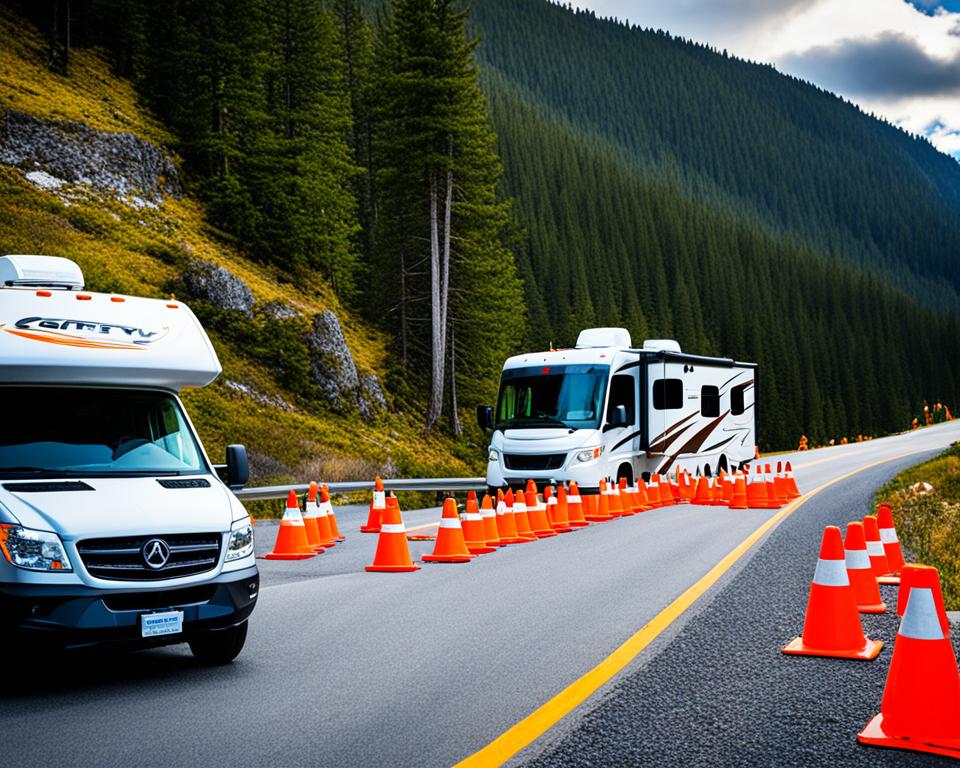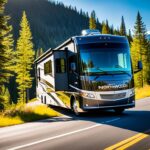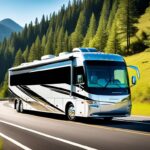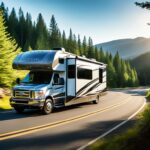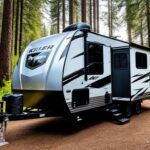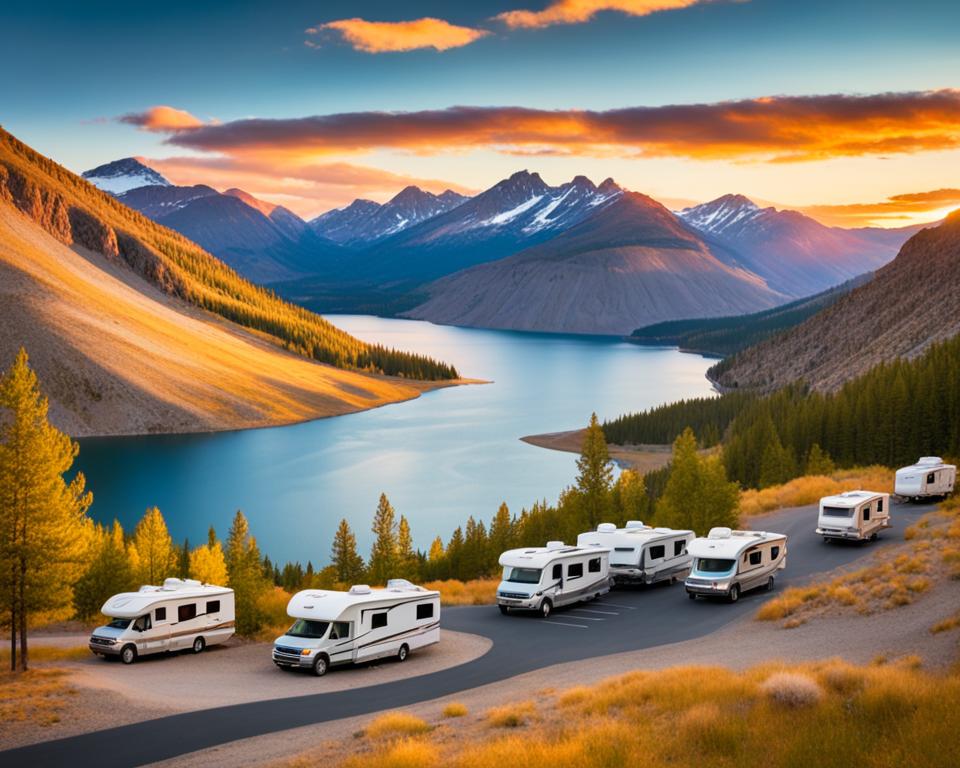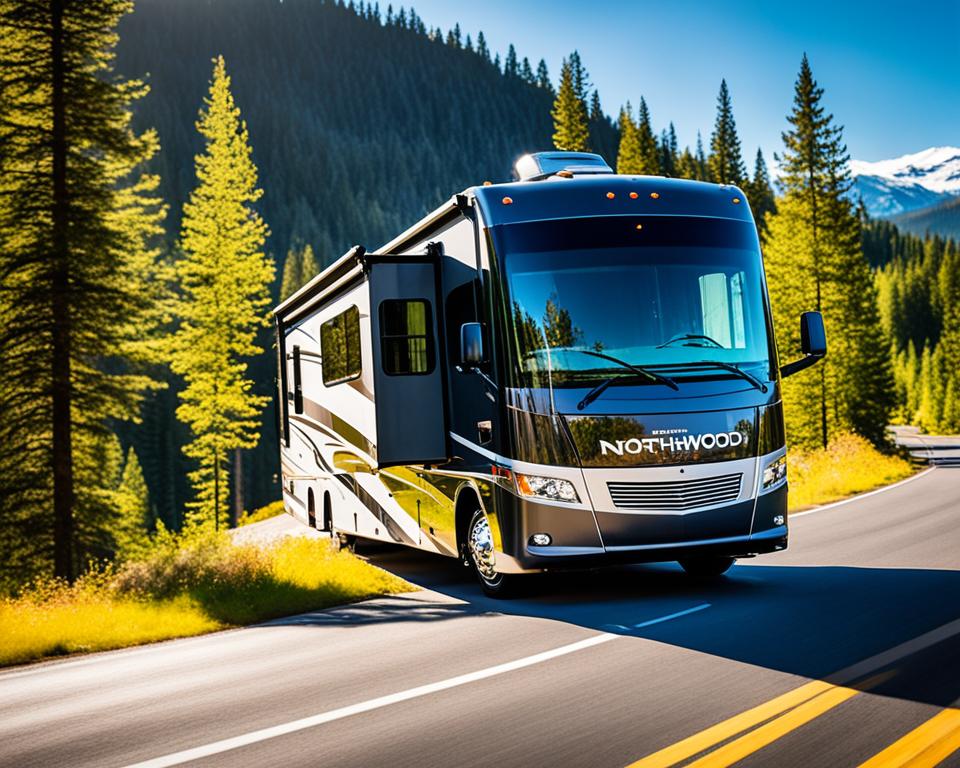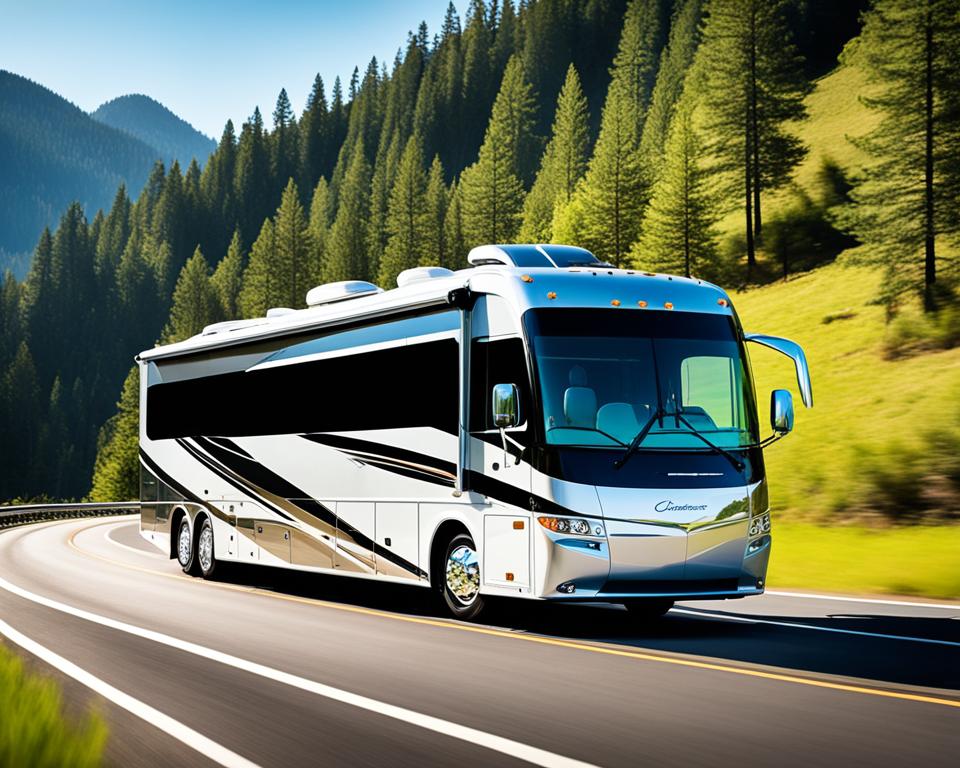RV camping is a popular way to travel and explore scenic destinations. However, it’s important to prioritize safety during your RV adventures. Here are some essential tips to ensure a safe and stress-free journey.
Key Takeaways:
- Follow RV safety guidelines to ensure a safe and enjoyable trip.
- Create an RV travel safety checklist to cover all necessary precautions.
- Take note of RV safety tips for beginners if you are new to RV travel.
- Implement essential RV safety precautions to prevent accidents and mishaps.
- Stay informed about top RV travel safety tips from experienced travelers.
Mastering Driving an RV
Driving an RV comes with its own set of challenges that require careful planning and skill. To ensure a smooth and safe journey, consider the following RV driving tips:
- RV Route Planning: When mapping out your travel itinerary, take into consideration the specific needs of your RV. Use an RV-specific GPS device or a reliable Trucker Atlas to avoid low bridges, narrow roads, and other restrictions that may be unsuitable for your vehicle.
- Practice Maneuvering: Find a large, empty parking lot where you can practice making wide turns and backing up with your RV. This will help you become more comfortable and confident behind the wheel.
- Awareness of RV Height Clearance: One of the common challenges of driving an RV is encountering low clearances. To avoid collisions, make a note of your RV’s height and be vigilant when approaching bridges, tunnels, gas station canopies, and other structures with height restrictions.
- License Requirements: Different states have different requirements for driving certain classes of RVs. Before embarking on your journey, familiarize yourself with your state’s regulations to ensure you are properly licensed.
- Stay Informed: Keep yourself updated on traffic conditions and construction work along your route. Utilize free apps and websites that provide real-time traffic updates to help you plan your journey more efficiently.
- Consider an RV Driving Course: If you are new to RV driving or want to enhance your skills, consider enrolling in an RV driving course. These courses offer valuable insights, techniques, and hands-on practice to help you become a more confident and competent RV driver.
By following these RV driving tips, you can navigate the roads with ease and enjoy a stress-free RV adventure.
Testimonials from Experienced RVers:
“Planning the route ahead and using an RV-specific GPS device has saved us from many stressful situations. It gives us peace of mind knowing that we won’t encounter any unexpected obstacles or low clearances.” – John and Emily, Full-time RVers
“Taking an RV driving course was one of the best decisions we made before hitting the road. It helped build our confidence and taught us essential skills that have made our travels much smoother.” – Mike and Lisa, RV Enthusiasts
Including Safety Essentials in your RV Packing List
When embarking on an RV trip, it’s crucial to prioritize safety. As you pack for your journey, make sure to include these essential safety items in your RV packing list:
- A comprehensive first-aid kit, equipped with bandages, antiseptic ointment, pain relievers, and other necessary medical supplies.
- A reliable fire extinguisher to quickly and effectively respond to any fire emergencies.
- Jumper cables to tackle dead battery situations and ensure uninterrupted travel.
- Duct tape and electrical tape for temporary repairs and fixes on the go.
- Motor oil and other necessary fluids to maintain the optimal performance of your RV.
- A tire pressure gauge to regularly monitor and maintain appropriate tire pressure for safe driving.
- Spare batteries and a battery charger to power your essential electronic devices.
- Wheel chocks or blocks to provide stability and prevent unintentional movement while parked.
- A comprehensive guide to operating your RV in cold weather, ensuring you are equipped to handle challenging conditions.
- Contact information for campgrounds along your planned route, so you can easily reach out for assistance or reservations.
- Important documents, including your RV registration, insurance papers, and warranty documents, providing proof of ownership and legal compliance.
- A list of emergency contacts and necessary medications, ensuring you have important information readily available.
- A tarp to protect your RV and belongings from adverse weather conditions.
- A collapsible shovel for various outdoor tasks, such as leveling your RV or clearing paths.
- Flashlights with extra batteries, allowing you to navigate in low-light situations.
- A surge protector and extension cords to safely connect your RV to external power sources.
- Reusable water bottles, promoting hydration during your travels.
“Remember, proper preparation and including these safety essentials in your RV packing list can make a significant difference in ensuring a safe and enjoyable journey.” – Experienced RV Traveler
Ensuring Child Safety in your RV
When embarking on an RV adventure with your family, the safety of your children should always be a top priority. By following these guidelines, you can provide a secure environment for your little ones throughout the journey.
- Seatbelt Safety: Ensure that all passengers, especially children, wear their seatbelts at all times while the RV is in motion. Seatbelts save lives and help prevent serious injuries in the event of an accident.
- Proper Seating: Children should sit in designated front-facing travel seats that are specifically designed for their safety. Avoid having children ride in side-facing seats, as they offer less protection in the event of a collision.
- Know the Car Seat Laws: Research the car seat laws in your state and the state(s) you plan to travel to. It’s important to comply with these laws to ensure your child’s safety and avoid any legal issues.
- Avoid Hazardous Areas: Prevent children from riding or sitting in areas where appliances or furniture could potentially fall or unbolt during a collision. Secure any loose items and create a child-friendly seating and play area within the RV.
By implementing these safety measures, you can enjoy peace of mind knowing that your children are protected while traveling in the RV. Remember, their safety is paramount, and taking the necessary precautions will ensure a safe and enjoyable journey for the entire family.
Obtaining RV Insurance Specific to your RV and Travel Plans
Protect your RV and travel plans with the right insurance coverage. When it comes to RV insurance, it’s important to consider these factors:
Talk to a Local, Independent Insurance Agent
To ensure you have the best RV insurance coverage, it’s recommended to consult with a local, independent insurance agent. They have the expertise and knowledge to guide you through the process and help you find the insurance policy that suits your specific needs.
Provide Detailed Information About Your RV
When discussing RV insurance options with your agent, be prepared to provide detailed information about your RV. This includes the make, model, type, length, and value of your RV. The more accurate the information you provide, the better your insurance coverage will be tailored to your RV.
Consider Usage and Personal Contents
Discuss with your agent the number of days per year you plan to use your RV, as this may affect your insurance policy. Additionally, consider the value of personal contents inside your RV, such as appliances, furniture, and personal belongings. Including these items in your insurance coverage can provide additional protection.
Inform Your Agent About Modifications and Location
If your RV has undergone extensive modifications, such as added features or upgrades, it’s important to inform your insurance agent. This ensures that your policy accurately reflects the value of your RV post-modifications. Additionally, inform your agent whether your RV will be at an RV park or campground or if it will be mobile or permanently tied down. These factors can impact your insurance coverage.
Explore Ways to Save on RV Insurance Premiums
RV insurance doesn’t have to break the bank. Talk to your agent about ways to save on your premiums, such as bundling your RV insurance with other policies, maintaining a good driving record, installing safety features in your RV, and participating in RV driver training courses.
By following these tips and working closely with an insurance agent, you can obtain RV insurance coverage that provides the necessary protection for your RV and suits your unique travel plans.
| Factors to Consider | Importance |
|---|---|
| Talk to a Local, Independent Insurance Agent | High |
| Provide Detailed Information About Your RV | High |
| Consider Usage and Personal Contents | Medium |
| Inform Your Agent About Modifications and Location | Medium |
| Explore Ways to Save on RV Insurance Premiums | Medium |
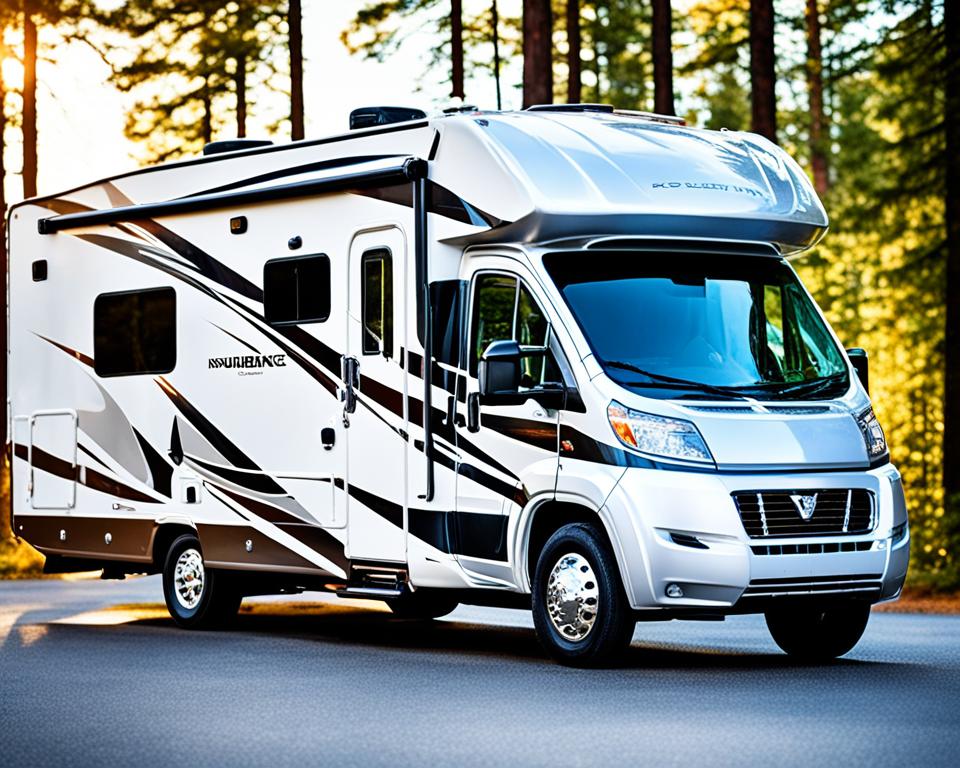
RVing Safety Tips from Experienced Travelers
Experienced RV travelers have accumulated valuable insights and safety tips over their journeys. These tips can help ensure a smooth and secure adventure during your RV travels.
1. Be aware of your surroundings and trust your instincts
When choosing places to park and stay, it’s essential to be mindful of your surroundings. Trusting your instincts can help you identify safe and comfortable locations.
2. Stay updated on weather forecasts
Weather conditions can greatly impact your RV travels. Stay informed about current and upcoming weather forecasts to plan your trips accordingly and avoid potential hazards.
3. Research the areas you’ll be visiting
Before you embark on your RV journey, take the time to thoroughly research the areas you’ll be visiting. Gather information about available services, amenities, and emergency resources.
4. Develop an escape plan
It’s crucial to have a well-thought-out escape plan in case of emergencies. When parking your RV, consider the layout and arrangement that allows for a quick and efficient exit if needed.
5. Have reliable means of communication
Ensuring reliable communication is crucial for safety during your RV travels. Consider investing in a cell signal booster or a satellite communication device to maintain connectivity, especially in remote areas.
6. Consider self-defense measures
While RVing is generally safe, it’s always better to be prepared. Consider self-defense measures such as personal alarms or self-defense tools to enhance your overall safety.
7. Have an emergency plan
Prepare an emergency plan in case of natural disasters or unexpected events. Discuss and rehearse the plan with your travel partner to ensure a coordinated response during emergencies.
8. Adhere to RV road restrictions and regulations
Pay close attention to RV road restrictions and regulations to avoid potential hazards and detours. This includes knowing height and weight restrictions, as well as any specific rules for RV travel in certain areas.
Table: RVing Safety Tips from Experienced Travelers
| Tips | Details |
|---|---|
| Be aware of your surroundings and trust your instincts | Choose safe locations for parking and staying |
| Stay updated on weather forecasts | Plan travels according to weather conditions |
| Research the areas you’ll be visiting | Gather information about available services and emergency resources |
| Develop an escape plan | Park in a way that allows for a quick exit |
| Have reliable means of communication | Invest in a cell signal booster or satellite communication device |
| Consider self-defense measures | Take precautions to protect yourself and your RV |
| Have an emergency plan | Prepare for natural disasters or separation from your travel partner |
| Adhere to RV road restrictions and regulations | Stay informed about size and weight restrictions, and specific rules in different areas |
By following these tips from experienced RV travelers, you can enhance your safety and have a memorable journey.
RV Driving Safety Tips for Beginners
If you’re new to driving an RV, it’s important to prioritize safety. Follow these tips to ensure a smooth and secure journey.
- Familiarize yourself with the rules and regulations: Before hitting the road, make sure you understand the specific guidelines for driving an RV. Check the legal requirements for obtaining the necessary license in your state or country.
- Take your time and drive at a safe speed: RVs need more time and distance to brake and maneuver compared to regular vehicles. Drive at a comfortable speed and allow for sufficient braking distance to ensure your safety and the safety of others on the road.
- Practice turning and backing up: Maneuvering an RV can be challenging, especially when it comes to making wide turns and backing up. Find a safe, open area and practice these maneuvers before your trip to build confidence and skill.
- Plan your routes carefully: Research and plan your routes in advance, taking into account RV road restrictions and potential hazards. Avoid narrow roads, low bridges, and areas with challenging terrain that may pose risks to your RV.
- Maintain proper RV maintenance: Regularly check and maintain your RV to ensure safe operation. Pay attention to tire pressure, check the condition of the brakes, and ensure proper weight distribution using a weight distribution hitch.
- Be mindful of weather conditions: Weather conditions can significantly impact RV driving. Stay updated on weather forecasts and adjust your driving accordingly. Avoid driving in severe weather conditions that may pose a threat to your safety.
- Use a spotter when backing up: Consider having a spotter assist you when backing up your RV, especially in tight spaces or unfamiliar areas. This extra set of eyes can help prevent accidents and guide you safely into your designated spot.
- Stay educated on RV driving and safety: Enhance your knowledge and skills by taking RV driving courses and seeking advice from experienced RV travelers. Learning from others’ experiences can provide valuable insights and tips for safe RV driving.
Following these RV driving safety tips for beginners will ensure a secure and enjoyable RV travel experience. Remember, safety should always be a top priority on the road.
Emphasizing RV Tire Safety
Proper tire maintenance is crucial for RV safety. By following these simple tips, you can help prevent RV tire blowouts and ensure a smooth and secure journey.
1. Inflate your RV tires to the manufacturer’s recommended air pressure
Keeping your RV tires properly inflated not only improves fuel efficiency but also enhances handling and reduces the risk of blowouts. Refer to your RV’s manual or the sidewall of the tire for the recommended air pressure.
2. Monitor tire condition and tread depth regularly
Inspect your RV tires regularly for signs of wear and tear. Check for cracks, bulges, or any abnormalities that may indicate the need for replacement. Additionally, measure the tread depth to ensure adequate traction on the road.
3. Consider investing in a tire pressure monitoring system (TPMS)
A TPMS is a valuable tool that constantly monitors your tire pressure and alerts you to any changes or abnormalities. It provides real-time data, allowing you to quickly address any issues to prevent tire blowouts.
4. Use tire covers to protect RV tires
RV tire covers serve as an additional layer of protection against the elements. They shield your tires from harmful UV rays, rain, and debris, extending their lifespan and preserving their performance.
5. Learn about RV weight limits and distribute weight properly
Understanding and adhering to RV weight limits is crucial to avoid overloading your tires. Uneven weight distribution, especially exceeding weight capacity on a particular tire, can lead to excessive heat buildup and potential tire blowouts. Use weight distribution hitches or sway control systems to maintain proper balance.
| Tire Maintenance Tip | Benefits |
|---|---|
| Inflate RV tires to recommended air pressure | – Improves fuel efficiency – Enhances handling – Reduces risk of blowouts |
| Monitor tire condition and tread depth | – Identifies signs of wear and tear – Ensures adequate traction |
| Invest in a TPMS | – Provides real-time tire pressure monitoring – Alerts to abnormal changes |
| Use tire covers | – Protects tires from UV rays and debris – Extends tire lifespan |
| Learn about RV weight limits | – Prevents overloading – Maintains proper tire balance |
Maintaining RV Weight and Load Distribution
Properly loading and distributing the weight in your RV is crucial for safe travels. By following these guidelines, you can ensure a balanced and secure journey:
- Determine your RV’s maximum cargo carrying capacity: Before you start loading your RV, find out the weight carrying capacity specified by the manufacturer. This will help you understand the limitations and avoid overloading.
- Distribute weight evenly: To maintain proper balance, distribute the weight throughout the RV. Avoid placing too much weight in one area, as it can affect the handling and stability of the vehicle. Spread the load across both sides and consider using storage compartments strategically.
- Keep track of your RV’s weight ratings: Monitor the weight of your RV during your trips. Stay within the specified weight ratings for axles, tires, and overall vehicle weight. Exceeding these limits can lead to safety hazards and damage to the RV’s components.
- Follow proper RV loading techniques: When loading your RV, place heavier items on the lower shelves and closer to the center of the vehicle. Secure loose items to prevent shifting during travel. Consider using bungee cords, cargo nets, or storage containers to keep items in place.
Properly loaded and distributed weight in your RV helps maintain control and stability on the road, ensuring a safe and enjoyable journey.
Weather Awareness for RV Travel
When embarking on your RV adventures, it’s essential to stay aware of weather conditions and take necessary precautions to ensure a safe and enjoyable journey. Unfavorable weather can pose challenges and potentially lead to travel delays or dangerous situations. By planning ahead and staying informed, you can mitigate risks and make better decisions regarding your travel plans.
Planning to Avoid Bad Weather
One of the best ways to handle bad weather during RV travel is to plan your trips carefully. Stay informed about weather forecasts along your route and at your destination. Check weather updates regularly to anticipate any severe conditions that may affect your travel. By proactively avoiding bad weather whenever possible, you can minimize the risks and discomfort associated with adverse weather conditions.
Staying Updated on Weather Forecasts
Keeping up-to-date with weather forecasts is crucial for safe RV travel. Use reliable sources of information, such as weather apps or websites, to stay informed about upcoming weather patterns. This will help you make informed decisions and adjust your plans accordingly.
Allotting Extra Travel Time for Weather-Related Delays
Weather-related delays can occur unexpectedly, especially during severe weather events. It’s essential to account for these potential delays by allowing extra travel time. This way, even if you encounter unfavorable weather conditions, you won’t feel rushed and can navigate the roads more cautiously.
Being Prepared for Severe Weather
In the event of severe weather, it’s crucial to be prepared and have a plan in place. Stay informed about any weather advisories or warnings issued for your location. If conditions worsen and it becomes unsafe to continue your journey, be ready to change your plans and find safe shelter until the weather improves.
Avoiding Driving in Hazardous Conditions
When facing heavy rain, fog, ice, or high winds, it’s best to avoid driving if possible. These conditions can reduce visibility, affect road grip, and increase the chances of accidents. If you encounter hazardous weather while on the road, find a safe place to pull over and wait until conditions improve before continuing your journey.
Remaining Cautious of Road Conditions and Hazards
It’s essential to stay vigilant and be mindful of road conditions and potential hazards during and after storms. Pay attention to any road closures, detours, or obstacles that may affect your route. Slow down if you encounter wet or icy roads and be aware of debris or fallen trees that may pose a hazard.
Stay informed, plan ahead, and make wise decisions to ensure a safe and pleasant RV travel experience, regardless of the weather conditions you may encounter on your journey.
Utilizing a Spotter for RV Parking and Backing Up
When it comes to parking and backing up your RV, having a spotter can greatly improve your visibility and maneuverability. Follow these RV parking tips to ensure a smooth and stress-free experience:
- Choose a reliable person to act as your spotter. This can be a fellow traveler or a trusted friend who is familiar with RV parking techniques.
- Use hand signals or walkie-talkies to communicate effectively with your spotter. Clear communication is essential to avoid accidents and missteps.
- Take your time and have patience while maneuvering your RV. Parking and backing up can be challenging, especially in tight spaces, so it’s important to remain calm and focused.
- Practice parking and backing up in open areas to improve your skills. Look for empty parking lots or large open spaces where you can hone your RV parking abilities without the pressure of other vehicles or obstacles.
- Use rearview cameras or mirrors to supplement the spotter’s guidance. While a spotter can provide valuable assistance, it’s still important to rely on your own visual cues and utilize technology to enhance your visibility.
Expert Insight
“Having a spotter while parking and backing up your RV is like having an extra set of eyes. They can provide crucial guidance and help you avoid potential obstacles or hazards. Just remember to establish clear communication and trust their instructions.”
– Mark Johnson, Experienced RV Traveler
Note: Image depicts an RV backing up with a spotter for improved visibility
Conclusion
Safety is an essential aspect of any RV travel adventure. By following these final tips, you can ensure a safe and enjoyable journey. First and foremost, prioritize careful driving and adhere to road regulations. Maintaining a vigilant and responsible approach to driving will help keep you and your fellow travelers safe on the road.
Additionally, it is crucial to stay prepared by equipping your RV with essential safety items. Include items such as a first-aid kit, fire extinguisher, and jumper cables in your packing list to handle any emergencies that may arise during your trip.
When traveling with children, prioritize their safety by following car seat laws and RV seating guidelines. Ensuring that children are properly secured in designated, front-facing travel seats will help minimize the risk of injuries in the event of an accident.
Obtaining the right insurance coverage for your RV and travel plans is equally important. Consult with a reputable insurance agent to explore your options and find the best coverage to protect your investment.
Remember to seek advice from experienced travelers and consider taking RV driving courses to enhance your driving skills and increase your confidence on the road. This knowledge, coupled with a keen awareness of weather conditions, will help you make informed decisions and adjust your travel plans accordingly.
Don’t forget to maintain proper RV tire safety and weight distribution, as this significantly impacts the overall safety and performance of your RV. Regularly monitor tire condition, check tire pressure, and distribute weight evenly to prevent tire blowouts and accidents.
Lastly, utilize spotters when parking and backing up your RV for better visibility and to avoid potential hazards. By being mindful of your surroundings and trusting your instincts, you can navigate your RV safely and effectively.
By prioritizing safety throughout your RV travel journey, you can enjoy a worry-free and memorable adventure. Keep these final safety tips in mind, and embark on your next RV trip with confidence.
FAQ
What are some essential RV travel safety tips and precautions?
Some essential RV travel safety tips and precautions include careful driving, proper RV maintenance, following road regulations, packing essential safety items, ensuring child safety, obtaining appropriate RV insurance coverage, staying aware of weather conditions, and utilizing spotters for parking and backing up.
How can I master driving an RV?
To master driving an RV, consider planning your route carefully, practicing wide turns and backing up in a big parking lot, noting the height of your RV to avoid collisions with low clearances, checking your state’s license requirements for driving certain classes of RVs, staying updated on traffic and construction updates, and considering an RV driving course to improve your skills.
What safety essentials should I include in my RV packing list?
Some safety essentials to include in your RV packing list are a first-aid kit, fire extinguisher, jumper cables, duct tape, electrical tape, motor oil/fluids, tire pressure gauge, spare batteries, battery charger, wheel chocks/blocks, a guide to operating your RV in cold weather, campground(s) contact information, RV registration and insurance papers, a list of emergency contacts and medications, a tarp, collapsible shovel, flashlights, surge protector and extension cords, and water bottles.
How can I ensure child safety in my RV?
To ensure child safety in your RV, make sure all passengers, especially children, wear seatbelts while the vehicle is in motion. Children should sit in designated front-facing travel seats, not side-facing seats. Research car seat laws in your state and the state(s) you’re traveling to and avoid letting children ride in areas where appliances or furniture could fall or unbolt during a collision.
What should I consider when obtaining RV insurance specific to my RV and travel plans?
When obtaining RV insurance, talk to your local, independent insurance agent to discuss your options. Provide information about your RV’s make, model, type, length, and value. Discuss the number of days per year you plan to use the RV, the value of personal contents inside the RV, any extensive modifications, whether the RV is at an RV park or campground, and if it’s mobile or permanently tied down. Explore ways to save on RV insurance premiums.
What are some RV safety tips from experienced travelers?
Some RV safety tips from experienced travelers include being aware of your surroundings and trusting your instincts when choosing places to park and stay, staying updated on weather forecasts, researching the areas you’ll be visiting, developing an escape plan, having reliable means of communication, considering self-defense measures, having an emergency plan, and adhering to RV road restrictions and regulations to avoid detours and hazards.
What are some RV driving safety tips for beginners?
Some RV driving safety tips for beginners include familiarizing yourself with the rules and regulations for driving an RV, taking your time and driving at a safe speed, practicing turning and backing up in a safe, open area, planning your routes in advance, keeping up with RV maintenance, being mindful of weather conditions, using a spotter when backing up, and staying educated on RV driving and safety by taking driving courses and seeking advice from experienced travelers.
How can I emphasize RV tire safety?
To emphasize RV tire safety, make sure to inflate your RV tires to the manufacturer’s recommended air pressure, monitor tire condition and tread depth regularly, consider investing in a tire pressure monitoring system (TPMS), use tire covers to protect RV tires from prolonged exposure to the elements, and learn about RV weight limits and distribute weight properly to avoid tire blowouts.
How should I maintain RV weight and load distribution for safe travels?
To maintain RV weight and load distribution, determine your RV’s maximum cargo carrying capacity and do not exceed it, distribute weight evenly to maintain proper balance, keep track of your RV’s weight ratings and stay within the limits, and follow proper loading techniques to prevent loss of control and excessive strain on the RV’s components.
How can I stay aware of weather conditions during my RV travels?
To stay aware of weather conditions, plan your trips to avoid bad weather whenever possible, stay updated on weather forecasts along your route and at your destination, allow extra time for travel in case of weather-related delays, be prepared to change your plans or find safe shelter in the event of severe weather, and avoid driving in heavy rain, fog, ice, or high winds when possible.
How can I utilize a spotter for better visibility during RV parking and backing up?
To utilize a spotter for better visibility during RV parking and backing up, choose a reliable person to act as your spotter, use hand signals or walkie-talkies to communicate effectively, take your time and have patience while maneuvering your RV, practice parking and backing up in open areas to improve your skills, and use rearview cameras or mirrors to supplement the spotter’s guidance.
How can I prioritize safety during my RV travel?
To prioritize safety during RV travel, remember to drive carefully and adhere to road regulations, pack essential safety items in your RV, ensure child safety by following car seat laws and RV seating guidelines, obtain the right insurance coverage for your RV and travel plans, seek advice from experienced travelers, stay aware of weather conditions, maintain proper RV tire safety and weight distribution, and utilize spotters when parking and backing up. Always be mindful of your surroundings and trust your instincts.

